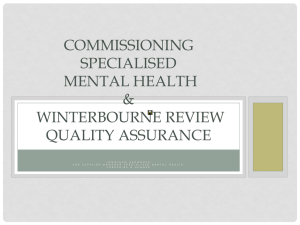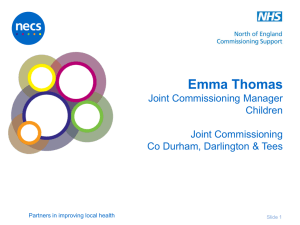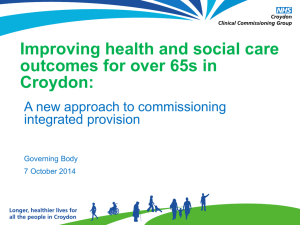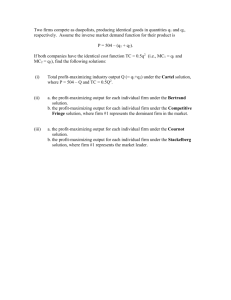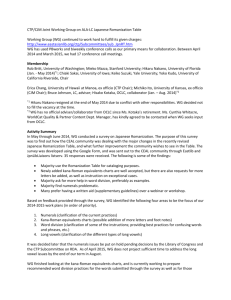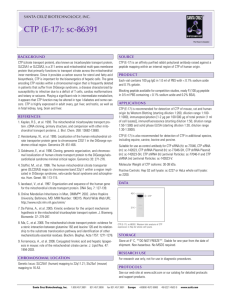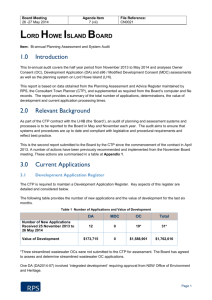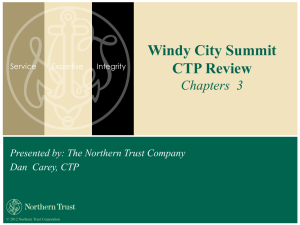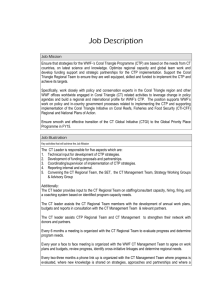NE Lincolnshire CTP – Geoff Lake & Lance Gardner
advertisement
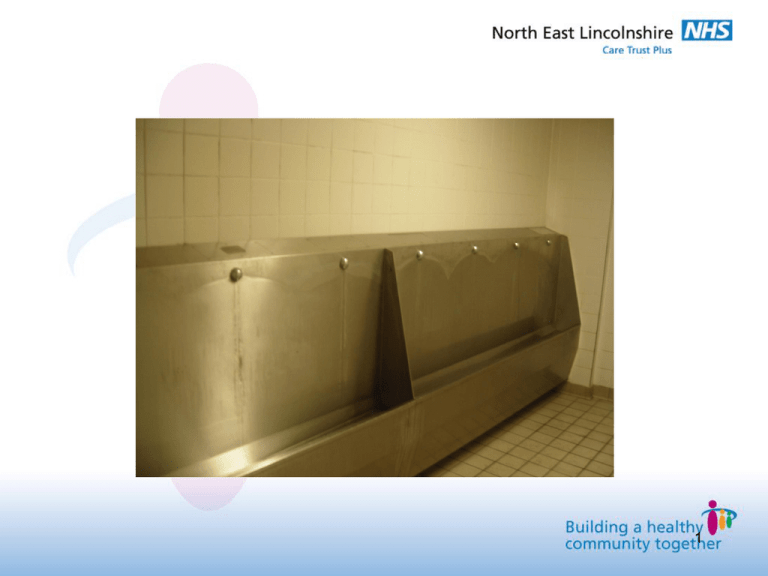
1 2 3 4 North East Lincolnshire Care Trust Plus Geoff Lake Lance Gardner 17 June 2010 5 Where?............ 6 Overview of North East Lincolnshire Care Trust Plus • • • • • Population of 168,000 89 GPs and 34 General Practices 1,500 directly employed staff 4 Commissioning Groups 2010/2011 budget – NHS is £287 million and Adult Social Care is £47 million • 37 contracts for provision of health care • 130 providers of social care 7 CTP Developed in Context of… • • • • • • • • Male life expectancy – 75.9 years (below national + regional average) Female life expectancy – 80.8 years (below national average) 49% of most deprived out of the 354 local authorities in England (2007) 24% of lower level super output areas in North East Lincolnshire are amongst the most deprived 10% in England High teenage pregnancy rates High level of smoking prevalence Third worst area in England for alcohol abuse High dependency ratio 8 Care Trust Plus • Established September 2007 • Three elements: ─ Delegation of planning, purchasing and delivery of Adult Social Care (Council to CTP) ─ Delegation of planning, purchasing and delivery of health improvement (CTP to Council) ─ Development of Children’s Trust ─ Council as preferred provider of Community Child Health Services 9 Care Trust Plus – Accountabilities Adult Social Care NHS Care Trust Local Authority Health Improvement Children’s Trust Commissioning Board 10 Characteristics of the CTP • A health and well-being organisation • Commissioning groups: front line integration • An organisation rooted in its community • Working as part of a wider care community 11 CTP – Role and Functions • Planning and purchasing of health and adult social care - £320m • Planning and purchasing at the level of the individual, the locality and the population • Contract management and procurement ie contract consortia for main Acute Hospital provider • Delivery of community health and personal care services 12 CTP Current Provision • • • • • • • • • Adult Mental Health services Learning Disability District Nursing and complex case management Integrated Tier 2 services Palliative Care and Specialist Nursing Drug Intervention Programme Meals on Wheels and transport services Day Care – Older People and Physical Disability Supported employment schemes 13 Four Commissioning Groups • Based on GP Practice populations • Hold budgets for: – Hospital care – Prescribing – Community nursing • • • • Care Management Teams aligned Community nursing Teams fully aligned Community membership scheme Lay Boards Integration 14 Key Governance Issues • Handling reserved matters • Political representation • The role of the Director of Adult Social Services • Communication and awareness • Answering the difficult questions at the start of the journey 15 Joint Governance • • • • Legal Partnership Agreement Three Year Strategic Agreement Financial Risk Share Agreement Continuing dialogue: – Executive Officers Group – Good Governance Group – Performance Group 16 Question 1: what do you want us to focus on? 17 Integration as a Catalyst for change & developing a focus on outcomes 18 The Integration Journey Driving forces: – Co-terminosity – Greater and faster progress needed in delivering better outcomes – Long and strong history of collaboration – Local stability within the NHS system – High trust relationships amongst local leaders – Strong sense of place and sound financial performance 19 The Integration Journey Key challenges: – View of the region and DoH – Robust but lengthy application process – Building local political and lay member support – Managing the impacts of organisational change – Building on belief rather than hard evidence 20 The Integration Journey Putting in the building blocks: – Harmonisation of terms and conditions – Working alongside as a precursor to integration – Integrated management structure and integrated support services – Developing a new language – Commissioning Groups at the heart of the new organisation 21 The Integration Journey • Development of whole system thinking • Integration driven at the strategic, tactical and individual level • Broader ownership and greater influence eg Carers • A wider set of levers deployed 22 Question 2: is integration a realistic option for you? • What does integration look like for you locally and why? • What would you need to do to become fit for purpose? 23 The Model of Delivery 24 Integrated Care Model NHS funding and regulation Interventions General population Regeneration Citizenship Neighbourhood Information access Lifestyle Practical support Prevention Personalised Housing Low to moderate needs Children's Trust Extended primary care Intermediate care Early intervention Transport Substantial needs Enablement Community support Institutional avoidance Acute Complex needs Specialised Shifts in investment Timely discharge Outcomes (Financial sustainability, user experience, quality) 25 Increasing numbers Increasing cost Whole System Partnership Escalating complexity related to fees, related in turn to competency of workforce Public bodies, accessibility and citizenship Emerging tiered approach 26 26 Community Clinical Activity Tier Health Duties Social Care Duties Health Professional Social Care Market / Provision Eye Drops Bloods Clexane – PGD Insulin – PGD Hygiene Nutrition Shopping Cleaning Health Support (Band 3) 2 in each CG but centrally supervised by Band 5 Nurse Basic care any Lay carer could reasonably perform Home Care Worker (Bands 2 & 3) Night Sitting Day Services Meals on Wheels Maintenance of Activities and Daily Living Community Nurse (Band 5) Health Support (Band 3) Providing health maintenance and prevention services Home Care Worker (Bands 3 & 4) Assistant Practitioner 2 Continence Assessments Stoma Care Bowel Care Basic Leg Dressings Nutrition Ear Syringing Health Advice Promotion 3 Long Term Conditions Complex Leg Dressings Palliation Drains PEG’s Invasive Procedures Intensive Home Support Bathing Nutrition Passive Therapies Case Manager (Band 6) Tier 3 becomes transitional tier with people moving from maintenance to increased need, and from complex care to maintenance 4 Multiple Long Term Conditions Complex Palliation Dementia Severe Disability 1 Complex Case Management (Band 7) Part of the broader Complex Care Management Team 3 Band 7’s in each CG Advanced Practitioner Social Care 27 • • • Emerging Achievements Reshaped Intermediate Tier - Re-ablement - Integrated menu of choice - Rapid Response - Workforce profile Long Term Care - Improvement in standards - Placement policy - Responsiveness and partnership - Range of support - End of Life - Dementia mapping - Infection control - Targeted improvements A3 Single Hub: - multi-function (Sept.) 00 Hours - Solution not service - Keeping individuals out of the labyrinth - No door is the wrong door 28 • Complex Case Management - Kaiser principles - ASC; the axis of ‘three’ - 5% + 20% - Single resource • Dementia - Social model of disability - De-medicalise - Systemic - Memory service not clinic 29 CTP: Emerging Benefits • Significant increase in quality ratings of Care Homes • No direct admissions to Care Homes from hospital • Redesign of Tier 2 services – reduction in hospital admission • Doubling the number of people helped to live at home 31 CTP: Emerging Benefits • Use of co-production models for health and personal care • Philosophy of normalisation developing within front line teams • Broader set of PIs and standards in contracts reflecting total care issues • Cost shunting ie NHS continuing care, transitions • NHS funding of care substitution • Management of winter pressures/incidents 32 CTP: Emerging Benefits • 35% reduction in formal social care referrals • Greater focus on prevention and re-enablement driving redistribution of resources • Use of integrated care to reduce costs and improve quality for those with the most complex needs 33 Reflections 34 MEANS AND BENEFITS (i) Integrated Commissioning Single resource • Single outcome framework - qualitative - quantitative • Market shaping: whole system - broader methodology - personalisation • Availability and Responsiveness 35 ENABLERS • Breeding leaders and believers - confidence - breaking the rules - doing it differently - devolving responsibility • Visible and sustained communications • Individual not ideology • Single workforce - competencies - pay - supervision • Shared care record 36 • Doing the ‘knitting’ consciously - Long-term care - Support at home - Neighbourhood - Tiers 37 • • • • A Parallel Journey Adaptive and flexible ‘means to an end not an end’ ‘Care’ not health, not social care Managers out of their comfort zone Separation and evolution - Social Enterprise - Integrated Commissioning 38 ADULT SOCIAL CARE: some messages • Insistent and Assertive • Establish credibility - internal - external • Strategic interpretation for the NHS • Single outcome framework (make the pool work) 39 • Performance - ASC: • New leaders and managers • New practitioner philosophy • Branding • Saying goodbye to some 40 Key Messages 41 • • • • Key Messages Make outcomes the goal and all else the servant Combine entrepreneur behaviour with business modelling Integrated Commissioning driving integrated delivery Identify, sustain, encourage new leaders: model the value systems required 42 Current Barriers to Personalisation • The regulatory system • Political see-saw • Cultural indoctrination • Eligibility • Traditional ‘workforce’ practices 43 Financial Approach 46 Managing Resources Clear and explicit documentation for each budget that sets out: ─ Which partner is accountable ─ Which partner is responsible ─ Who funds the risks that arise in-year and the approach to recurrent resolution 47 Establishing Partnership Budgets • Use 3 year costs and trends to inform partnership budgets • Formally agree how the budgets will be negotiated going forward (cost pressures, inflation, savings, investment priorities) 48 Moving to Pooled Budgets • Understanding each partner contribution but loss of identity on spend • Need to have built sufficient trust • Able to demonstrate accountability and delivery to everyone’s satisfaction • The services really need it • Start small 49 Language and Culture • Need a common language and process/ approach for: – Assessing and demonstrating VFM – Reshaping the use of resources to support delivery of priorities and outcomes • Transparency and trust need to be in place between the DOFs 50 Language and Culture • DOFs need to meet regularly and take a lead in strategic financial management, setting the tone of the overall financial relationship and unblocking problems • Expect to learn from each other and be open to this • Sharing teams and TUPE of back office staff really does help 51 Use of Shared Services • Reduces costs eg Council could reclaim VAT on community equipment purchases but the NHS couldn’t • Make best use of existing expertise/systems - debt collection • Can add assurance: use of LA internal audit service for Adult Social Care services • Reduce residual costs: £800k of back office services bought from the Council 52 Leadership is the capacity to translate vision into reality Warren G Bennis 53


